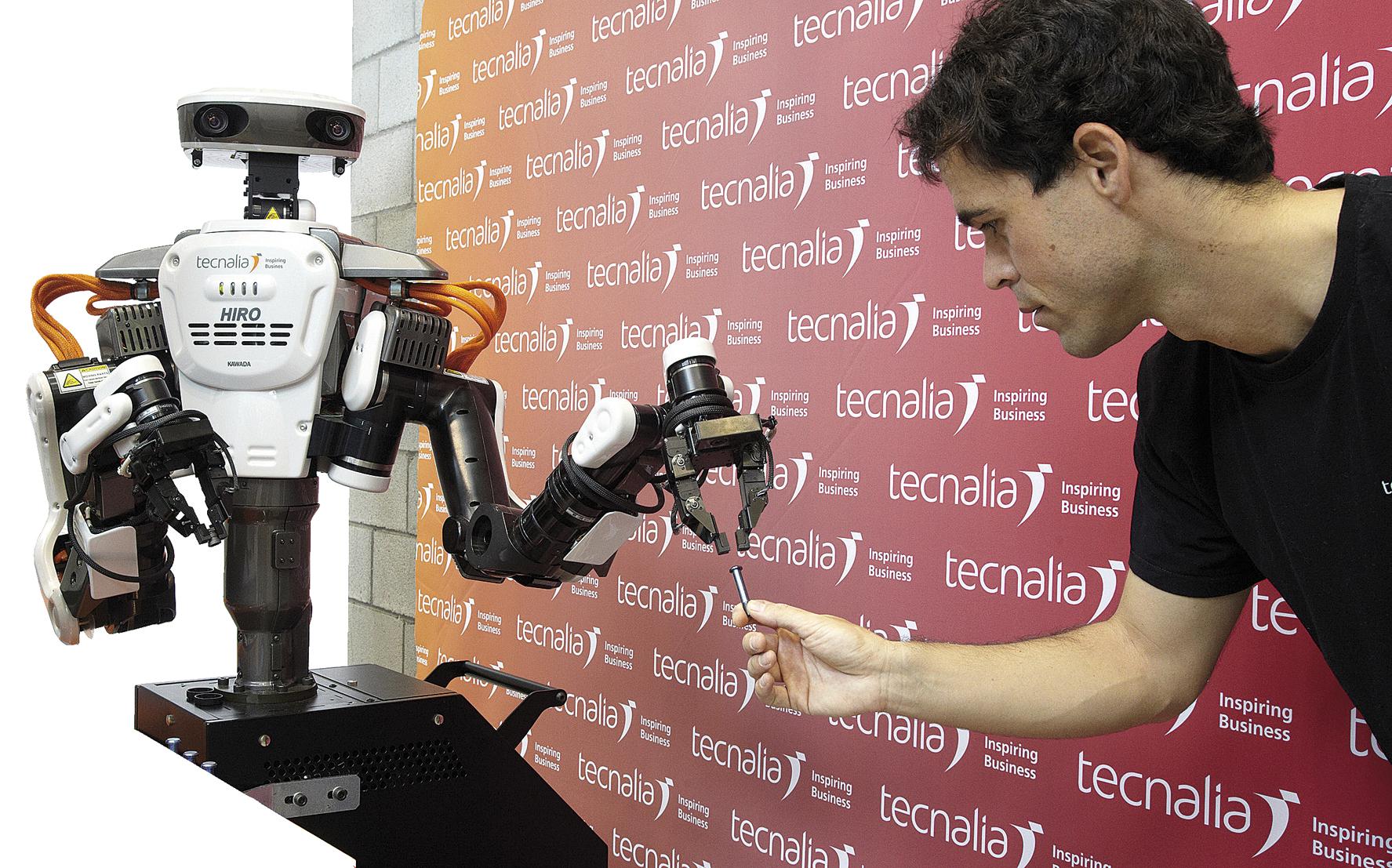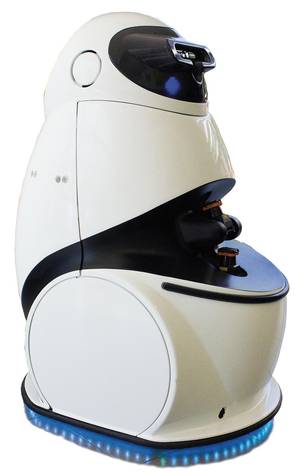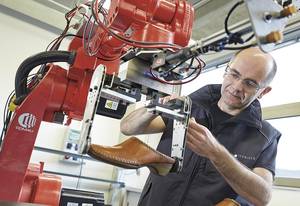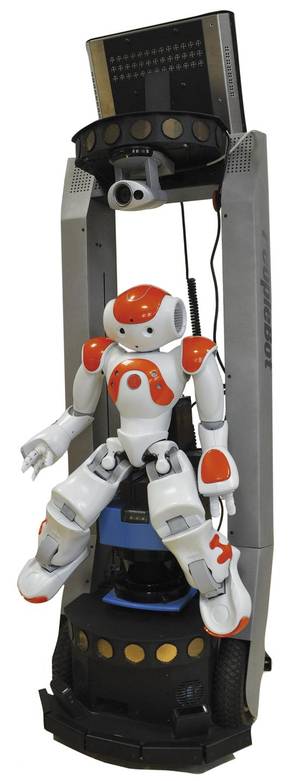Manual robots with people
2013/07/01 Lakar Iraizoz, Oihane - Elhuyar Zientzia Iturria: Elhuyar aldizkaria

Eureka has just started riding people! The last robot they have created at IK4-Tekniker in the Science Museum. When there is an event, it communicates it to the public and leads there, or conducts guided tours explaining the exposed exhibitions. A robot designed to interact directly with people.
It is more common for robots to devote themselves to industrial activities. However, in general, its level of automation is limited. "We want to go further," explains Urko Esnaola, a researcher who works with robots in the Industry and Transport division of Tecnalia. The introduction of advanced robotics in the industry would allow "to unite - adds Esnaolak- the advantages of robots, such as strength, precision and the ability to continuously repeat tasks, with the human characteristics that robots cannot have. People have the capacity to adapt. We are able, for giving a simple example, to take screws in any position and place them in the correct position in the corresponding piece. Well, by combining the skills of both, we want to increase production through the start-up of robots and people."
Along the same line is the researcher of the Autonomous and Intelligent Systems unit of IK4-Tekniker, Loreto Susperregi: "Our goal is for people to carry out tasks that provide added value to the product or process and automate low-value tasks, which may pose a risk or damage to health." The research centers aim to achieve a more competitive industry, and have eleven projects to offer robotic resources.
Example of this are the Hiro de Tecnalia robot and the one developed in the Robofoot project of IK4-Tekniker. The first is being developed for the aircraft manufacturer Airbus, specifically for the operation of placing rivets on the wings of the aircraft. "So far a person places the rivets in the holes and another one attacks them with a machine. For now we have managed to automate the first step", explains Esnaola. They have used this application to “verify and demonstrate in what kind of applications a robot of this type can be used”, he added. With this development they have won the European Manufacturing Award 2012.
On the other hand, in the Robofoot project, IK4-Tekniker tried to prove whether the penetration of the robot in the footwear sector was possible. "We started this project because it is a traditional sector that still does not have the robot in its manufacturing process," explains Iñaki Maurtua, director of the IK4-Tekniker Autonomous and Intelligent Systems Unit. "The aim was to robotize some of the manufacturing tasks, such as sanding, gluing, polishing, dying and tipping, support for shoe assembly, opening. It can also be used to make inspection once the shoes are finished and to put the shoes in the boxes". The project had the collaboration of the shoe company Pikolinos, who have tested it in its manufacturing process, and "we have shown that it is possible to introduce automation in this sector without great economic efforts".
Robots outside cages
In order for robots to work with people, researchers say that the first thing to get is for robots and people to share the same space. "Robots now work in cages in the industry and no one can enter it because it is dangerous," explains Esnaola. The safety standards are very strict. However, as technology advances, "the regulations are also in the process of change; they are going to say what measures must be done by robots and people so they are collaborating," explains Susperregi.
Thanks to the sensors and cameras being developed, robots can be able to recognize people and thus avoid the risk of playing with them. Likewise, robots must be able to overcome the barriers that people can make. To do this, researchers are also developing intelligence: "If the robot goes from one point to another and finds some obstacle in the way, it must be able to change its path and direct its planning," explains Susperregi.
Intuitively, it seems easy to do, "because we humans are very good adapting ourselves to the changes - Esnaola- highlights. But introducing something similar to intuition into robots is a big challenge, since everything has to be programmed."
Likewise, it is intended that the exchange between robots and people is as simple as possible and that the robot has more intuitive systems. "The goal is that the robot is not something that scares us because we don't know how to use it," says Esnaola.
Most of the work to be done to achieve this is in programming. According to Esnaola, "the key is to introduce the robot to a higher level of intelligence to work better. Sometimes we also have to introduce the hardware because the robot needs a better camera for a specific task, or because it needs different hooks to catch the pieces." But Basque researchers mainly work with the software: "We create intelligent behaviors with the signals of the sensors that have the robots," explains Maurtua.
For example, the Eureka robot! It is full of sensors to detect everything that surrounds it. "It has been a great challenge to be able to navigate robots surrounded by people. And it is that people move, it is not like a stagnant table, something that once perceived must only be avoided - says Susperregik-. In addition, it is very important that the robot knows whether the person in front is a person or not, to have an intelligent behavior, that is, not to start talking to a wall."
In contact with people, Susperregi clarifies that for the moment the robot has a unidirectional interaction: "He speaks to the person in front of him, but he is not able to hear or understand what that person can say to him." However, this technology is being developed and integrated "when we are convinced that it works properly".
Bertsos Bertsos Bertsos Bertsos Bertsos Bertsos
The challenge is to provide researchers with the ability to listen. In short, "audio is a sound wave with waves and gaps of determined frequency. Well, by collecting these frequencies, the robot must derive letters and hence the word, and by identifying a succession of words, it must solve its meaning." Elena Lazkano, member of the Research Group on Robotics and Autonomous Systems of the UPV/EHU, explains this fact. "There are tools for other languages, but the Basque language has many particularities, and in that we are working," he says. Its best-known creation is the bertsolari Tartalo, developed in collaboration with the UPV IXA Group.
The truth is that like almost all robots mentioned (Eureka! Except that of the museum), the robot itself has not been built by them, but by the intelligence it has behind; in this case, being able to make bertsos. Thus, like Tartalo, they can put other robots in bertsos. Among other things, they have done some sessions with the last robot that have entered the team: With Nao.
The team of the UPV-EHU opted for bertsolarism as a topic of capacity development for robots, “because bertsolarism is a hobby that we like, on the one hand, and on the other, because it allows to work in different areas of robotics, such as navigation and exploration, understand and internalize the topics that are proposed and generate a response to it. All this, in addition, with an adequate body expression, that is, expressing that he is thinking, acting like bertsolaris, etc. ", explains Basilio Sierra.
In addition to working on interaction between people and human beings, they consider that putting robots in berths is a good way to show society the work they are doing. However, this technology developed can also be useful for other services, such as “if you are a conductor of a museum, to care for people who come to speak, or to take patients to the clinic who want to go to a hospital,” explains Sierra.
Aesthetics, essential
Having to relate to people, the aspect of robots is a very important topic, according to the researchers. Lazkano says that "humans have the ability to communicate with humans, so we can start talking to a humanoid robot like Nao more than with an iron gadget like Tartalo. Therefore, if we want to attract people to the robotic world, we have to offer something attractive."
Although the importance of the use of humanoid robots is spreading lately, "in Japan they have been developing such robots for 10 years," says Urko Esnaolak--. In Europe we have focused more on industrial robots". Precisely for this reason, Esnaola is making a stay in the JSK laboratory of the University of Tokyo to continue developing the Hiro robot. Hiro himself is humanoid from the waist upwards, since although it is designed to help in the industry, the goal is to collaborate with people.
Eureka! the robot for the museum of science has not been seen as human, but "we have taken great care of aesthetics", explains Susperregi. Lazkano suggests that it resembles the robot Eva de Wall-e, the other way around. In the course of the test several sessions were held to see people's reaction to this situation and Susperregi recalls that once a young man approached him and asked him if he wanted to be his friend. "After all, people respond to robots and, before appearance, expect to have a certain behavior," he says.

Gai honi buruzko eduki gehiago
Elhuyarrek garatutako teknologia









